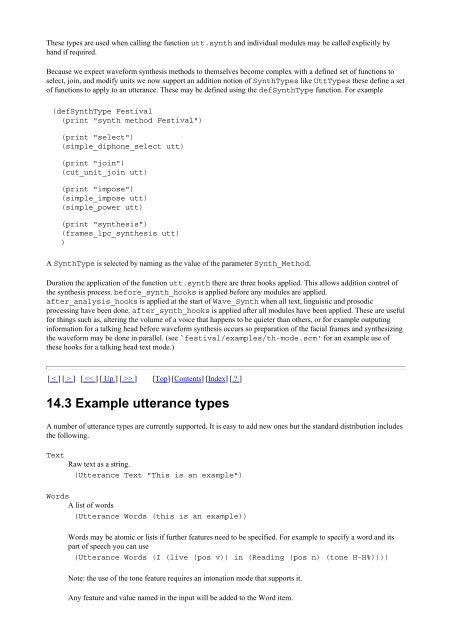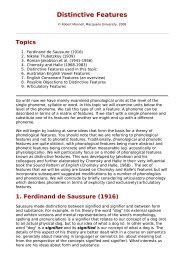Festival Speech Synthesis System: - Speech Resource Pages
Festival Speech Synthesis System: - Speech Resource Pages
Festival Speech Synthesis System: - Speech Resource Pages
Create successful ePaper yourself
Turn your PDF publications into a flip-book with our unique Google optimized e-Paper software.
These types are used when calling the function utt.synth and individual modules may be called explicitly by<br />
hand if required.<br />
Because we expect waveform synthesis methods to themselves become complex with a defined set of functions to<br />
select, join, and modify units we now support an addition notion of SynthTypes like UttTypes these define a set<br />
of functions to apply to an utterance. These may be defined using the defSynthType function. For example<br />
(defSynthType <strong>Festival</strong><br />
(print "synth method <strong>Festival</strong>")<br />
(print "select")<br />
(simple_diphone_select utt)<br />
(print "join")<br />
(cut_unit_join utt)<br />
(print "impose")<br />
(simple_impose utt)<br />
(simple_power utt)<br />
(print "synthesis")<br />
(frames_lpc_synthesis utt)<br />
)<br />
A SynthType is selected by naming as the value of the parameter Synth_Method.<br />
Duration the application of the function utt.synth there are three hooks applied. This allows addition control of<br />
the synthesis process. before_synth_hooks is applied before any modules are applied.<br />
after_analysis_hooks is applied at the start of Wave_Synth when all text, linguistic and prosodic<br />
processing have been done. after_synth_hooks is applied after all modules have been applied. These are useful<br />
for things such as, altering the volume of a voice that happens to be quieter than others, or for example outputing<br />
information for a talking head before waveform synthesis occurs so preparation of the facial frames and synthesizing<br />
the waveform may be done in parallel. (see `festival/examples/th-mode.scm' for an example use of<br />
these hooks for a talking head text mode.)<br />
[ < ] [ > ] [ > ] [Top] [Contents] [Index] [ ? ]<br />
14.3 Example utterance types<br />
A number of utterance types are currently supported. It is easy to add new ones but the standard distribution includes<br />
the following.<br />
Text<br />
Raw text as a string.<br />
(Utterance Text "This is an example")<br />
Words<br />
A list of words<br />
(Utterance Words (this is an example))<br />
Words may be atomic or lists if further features need to be specified. For example to specify a word and its<br />
part of speech you can use<br />
(Utterance Words (I (live (pos v)) in (Reading (pos n) (tone H-H%))))<br />
Note: the use of the tone feature requires an intonation mode that supports it.<br />
Any feature and value named in the input will be added to the Word item.
















